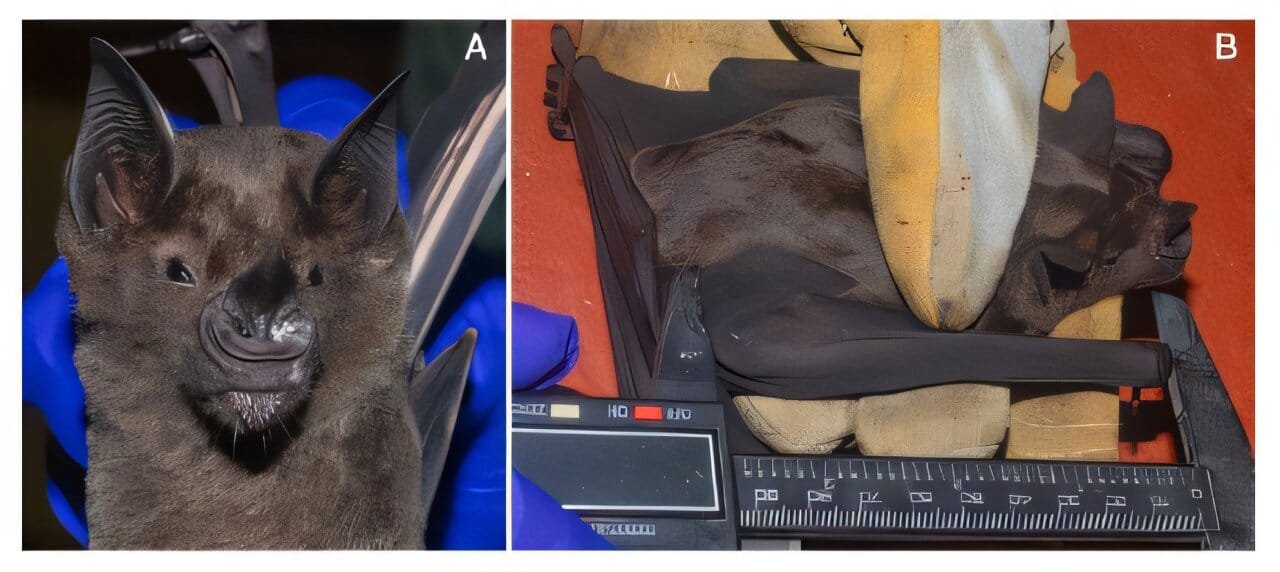Beneath the emerald canopy of southern Mexico’s Lacandona rainforest, the great Ceiba pentandra—known locally as the Kapok tree—stood like a silent sentinel. Its massive trunk, hollowed by time and teeming with life, cradled an ancient secret that had remained untouched by science and unseen by the human eye. Deep within its shadowed core, two pairs of glossy brown wings stirred in the dark, folded tightly against warm bodies. They belonged to Phyllostomus hastatus, the greater spear-nosed bat—until now, a stranger to Mexico.
The bats, silently roosting near the banks of the Lacantún River, had gone undetected for centuries in this stretch of the tropical wild. But their discovery, as documented in the journal Check List, marks a thrilling new chapter in the region’s biodiversity. These two individuals—small and silent as they may seem—carry with them a story that stretches far beyond the forest and into the heart of ecological science.
An Unexpected Encounter in a Familiar Forest
The Lacandona rainforest in Chiapas is no stranger to diversity. This biologically rich stretch of jungle, near the Guatemalan border, is among the most ecologically vibrant areas in the world. Towering trees, elusive jaguars, shimmering birds, and darting reptiles all find sanctuary here. But it was within this green cathedral, in a Kapok tree by the river, that a team of researchers—J. Manuel Aranda-Coello, L. Arturo Hernández-Mijangos, and Manuel Weber—made their unlikely discovery.
The bats’ presence marks an expansion of their known habitat, now extending their range about 75 miles northwest from their closest known occurrence in Alta Verapaz, Guatemala. The encounter, subtle as it may have appeared, had the power to shift boundaries on scientific maps and raise urgent questions about conservation.
The Anatomy of a Discovery
When the researchers peered into the hollow of the Ceiba tree and glimpsed the bats, it wasn’t immediately clear that they were looking at something new to the region. But their trained eyes caught telling signs. The creatures sported large, well-developed nose leaves, key adaptations that aid in echolocation, the biological sonar used by bats to navigate through the night. Their tails were present, a detail that distinguished them from similar species. Their forearms, stretching nearly three inches, suggested a robust frame, and their dark brown fur and leathery skin matched known characteristics of Phyllostomus hastatus.
Most striking of all was their sheer size. These were not small, delicate bats flitting through the forest. These were the second-largest bat species in the Neotropics—the tropical regions of the Americas—built to fly far, forage wide, and survive in habitats that may be separated by many miles of fragmented forest. With powerful, muscular wings, they could easily travel large distances, connecting distant populations and pollinating plants across wide swaths of land.
A Tree Unlike Any Other
The Kapok tree, once revered by ancient Mayans as the sacred “world tree” connecting heaven and earth, now bears a new meaning. This is the first recorded instance of Phyllostomus hastatus using a Kapok tree as a roosting site, an ecological detail that adds richness to our understanding of the species’ behavior. Traditionally, these bats have been associated with cave systems and less-exposed roosts, but the hollow trunk of this Ceiba offered safety, shade, and a perfect acoustic chamber for their echolocation calls.
This new behavioral data, humble though it may seem, expands scientific models of the bat’s ecological flexibility. It reveals the importance of tree cavities—not just caves—as critical habitats for large-bodied bats. In a time of rapid deforestation, knowing where a species can survive is just as vital as knowing where it currently lives.
The Looming Shadow of Deforestation
The researchers did not merely document a new range and roosting site; they raised the alarm. The Lacandona rainforest, though lush and green in pockets, is under siege. Illegal logging, agricultural expansion, and human settlement are gnawing away at the edges of this once-continuous forest. Habitat loss is not a future threat—it’s a present danger.
If these two bats represent the only known population of greater spear-nosed bats in Mexico, they are living on borrowed time. Their survival may depend on urgent conservation measures. The researchers urge that the species be added to Mexico’s official list of protected and threatened species, a step that could bring funding, legal safeguards, and public awareness to their plight.
Moreover, this single observation could be the tip of an iceberg. How many more individuals remain hidden in the canopy? How many more discoveries await in the deep green quiet of the Lacandona?
Guardians of the Night Sky
Bats have long been misunderstood. Cloaked in myths and vilified in folklore, they are often dismissed as eerie or dangerous. But the greater spear-nosed bat is a marvel of evolution, a complex creature that serves as a pollinator, seed disperser, and insect controller. Its role in the rainforest is vital, its presence a sign of ecological health.
Despite its formidable appearance—with spear-like nose and wide wings—it is no predator of terror. Instead, it lives a life of nocturnal precision, navigating the night with sonar more sensitive than anything humans have invented. It communicates with others using high-pitched calls and social behaviors, forming tight-knit colonies and displaying cooperative behaviors rarely seen in other mammals.
Their discovery in Mexico is not just a zoological update. It’s a reminder that the world is still full of wonders—if only we look closely enough.
A Call for Curiosity and Care
This tale of a bat in a tree may seem small compared to the great crises of our time. But it is in these intimate discoveries—in the quiet places where science and nature meet—that we are reminded of the delicate threads that bind all life together. The discovery of Phyllostomus hastatus in Chiapas is a testament to the value of exploration, the urgency of conservation, and the astonishing diversity that still flickers in the forgotten corners of our world.
As we rush forward into a century of change and uncertainty, let us remember the Ceiba tree by the Lacantún River, where two creatures hung in the dark, waiting to be seen. They are a whisper from the wild, asking not only to be noticed, but to be protected.
They are the breath of the forest at night.
Reference: J. Manuel Aranda-Coello et al, First records of Phyllostomus hastatus (Pallas, 1767) (Chiroptera, Phyllostomidae), Greater Spear-nosed Bat, in Mexico, Check List (2025). DOI: 10.15560/21.4.652






